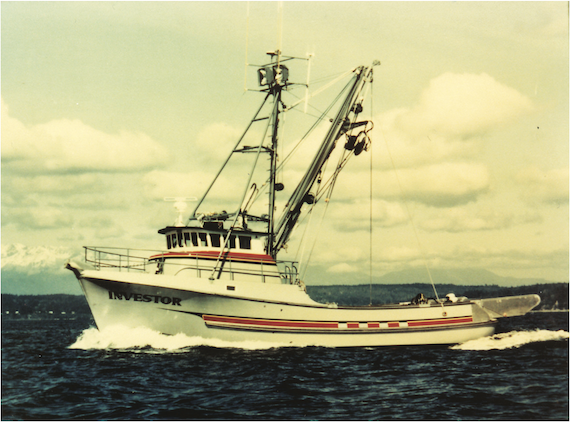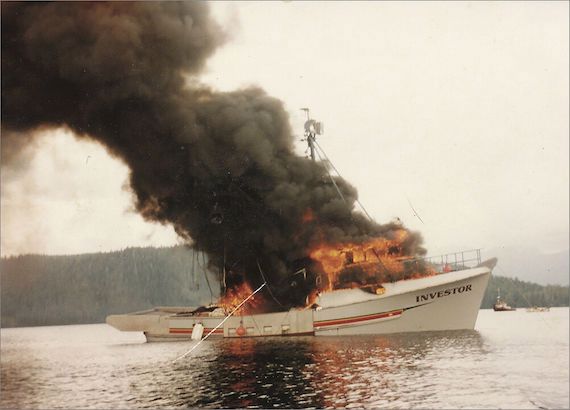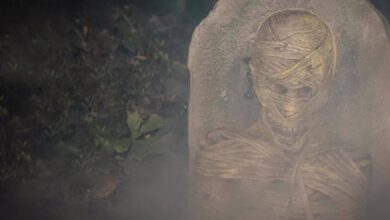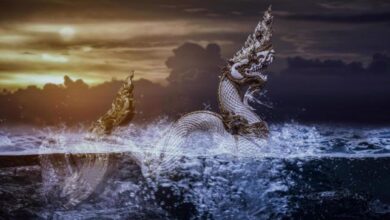A Mysterious Unsolved Mass Murder at Sea

Sept. 5, 1982, started out as a great day for Mark Coulthurst. The skipper of a commercial fishing vessel based out of Blaine, Washington, in the United States, he had recently acquired the high tech fishing boat the Investor and that day he was at the tiny southeast Alaskan fishing village of Craig for the final days of the commercial fishing season. That evening he, his pregnant wife, Irene, both 28, along with their children Kimberly, 5, and John, 4, celebrated his 28th birthday at a restaurant near the docks after having offloaded their haul of 77,000 pounds of salmon earlier that day, and boarded the Investor at around 9:30 p.m., along with four deckhands — Chris Heyman, 18; and Keown, Moon and Mike Stewart, all 19. They were all in good spirits as they headed to their boat to turn in for the evening and no one would have ever expected that this was the last time anyone would see them alive or that they were going to become the center of one of the grimmest unsolved mysteries in Alaska history.
The following day, the Investor was found anchored in a lonely harbor nearby Fish Egg Island, about one mile outside of Craig, and at the time no one thought much of it. When it was seen still anchored there the next day, it was thought to be a little odd, but even then no one really paid it much thought, mostly busying themselves with the end of the fishing season. It was not until later that afternoon when smoke could be seen billowing out of the boat that alarm bells were raised and the authorities were notified. Then Craig police chief Ray Shapley would say of the eerie scene that they arrived to:
When I got there [to the boat], black smoke was coming out of the wheelhouse, but there was nobody on deck. It made the hair on the back of my neck stand up.

Things would get even worse when the blaze was extinguished and police actually boarded the vessel to find the charred remains of all of the people who had been on board, so badly burned that they could not be immediately identified. They would later be found to be the bodies of Mark Coulthurst, his entire family, and what was suspected as all four deckhands, although not all of the remains could be conclusively identified or found at all, likely destroyed in the inferno, and an autopsy showed that Mark and Irene had been shot with a .22-caliber pistol or rifle execution style, likely as they slept. The other bodies were too badly charred to determine if they had been shot as well, but investigators believed that all eight victims had been killed before the fire had started. The boat also showed evidence that someone had tried to sink it by allowing seawater to flood the engine-cooling system. It was now thought that someone had snuck aboard at some point, shot the victims, and then set the boat on fire to cover their trail after failing to sink it. The police then began a murder investigation into one of the most brutal mass murders Alaska had ever seen, but they would only uncover more mysteries.
It was soon found that several other skippers had seen the Investor leave the docks at Craig, and that there had been some odd clues that no one had really thought too much of at the time. One crewman aboard the fishing vessel the Decade recalled that the Investor had rather strangely glided out towards the port with its engines off, and had left behind its expensive tie-down lines. On the deck there had been a man who he had assumed to be Mark, although he could not be sure. Apparently this man waved to him nonchalantly before continuing to go off on his way. Typically, crews wouldn’t start pulling away from a dock unless they had the engine running, so it was suspected that the family had already been killed at that point, and that the man seen on the deck was the perpetrator trying to slip out into the harbor without drawing attention to himself. Several other witnesses on other boats also claimed to have seen this man, but they could not give many details other than he seemed to be a white male in his early 20s with a pockmarked complexion, slim build, and wearing glasses with rectangular lenses.

More digging showed that several witnesses had noticed a man matching this description in a skiff going back and forth between the Investor several times as it had been anchored at Fish Egg Island, and also a young man of that description had been seen purchasing two-and-a-half gallons of gasoline in Craig itself on the morning of the day the boat was found burning. It was strongly believed that the man seen on the deck, the man in the skiff, and the one who had bought the gasoline were all the same person, the killer. The problem was, police couldn’t figure out any possible motive for such a heinous crime. Mark and his family didn’t know anyone in Craig, as it had been their first time to go there, and although they had recently pulled in $30,000 for their haul of fish, none of that had been in cash. In fact, Mark typically eschewed carrying large amounts of cash with him, and in fact had been trying to borrow money to pay for dinner the evening they were last seen. Even among the other skippers who had recognized him, Mark was found to be well-liked in the fishing community, with no known enemies and certainly with no one who would have hated him enough to kill his entire family and crew in such a cold-blooded manner. There was also no evidence that he had been involved with the drug trade, which shot down one of the initial ideas that it had been a drug deal gone bad. Another oddity was that no one could figure out just why the perpetrator would so brazenly set fire to the vessel in broad daylight, or why he had waited a whole day before doing so. Sergeant Charles Miller of the Alaska State Troopers has said of this:
Every time I pursue something, I keep coming up short. There’s always something that doesn’t fit. One thing that has stuck in my craw is why the murderer didn’t burn the boat right away, or at night when there was darkness to cover his escape? There must have been some compelling reason that caused him to do it in broad daylight.
The best idea they had at the time was that one of the people on board had gotten into a heated argument with someone and been shot, after which the perpetrator had killed everyone else in a spontaneous bid to leave no witnesses, and that he had spent some time trying to figure out his next move, but there was absolutely no real evidence to this effect. Alaska State Trooper Captain Mike Kolivosky would say of the theory:
We’re now looking at the possibility that one of the guys had alienated someone, causing the guy to go off the deep end… Maybe he didn’t intend to kill everyone, but it blossomed into that. Maybe someone felt cheated out of his fair share.
Making things even more confusing was that descriptions of the man seen sometimes varied, with some saying he was middle aged and stocky, rather than slim. Due to the complete lack of any clear motive, no solid, reliable description of the man who had been seen, a crime scene decimated by fire, the ship scuttled, and no new leads or clues, there was very little for the police to work with and the case went completely cold. It would not be until nearly two years later that police would finally find a potential suspect in the form of a young man named John Kenneth Peel, who not only matched the description they had of the killer, being identified by at least four witnesses, who claim to have seen him on the Investor’s skiff traveling to and from the craft in the days around the murder, but had also once served as a crewmember for Mark Coulthurst, having worked with him aboard his previous ship during the 1980 and 1981 fishing seasons. Peel had also been in Craig at the time of the killings working on another boat, putting him in the area. The idea was that things had soured between them, possibly due to Peel being fired, and this had spiralled into ruthless murder. Despite having only circumstantial evidence against Peel at best, it was decided to file a criminal indictment against him, officially charging him with all eight murders as well as one count of first-degree arson. Peel’s lawyer, Phillip Weidner, would lament of this:
From the moment it was issued, I have always said the indictment was not worth the paper it was written on. Of the many cases that I’ve encountered in my career, I’ve never seen such serious charges brought on the basis of the weak evidence reflected by the record in this case. Although it’s unfortunate that there even has to be a trial, I and Mr. Peel are looking forward to an opportunity to point out to a jury the lack of evidence and the unreliability of the state’s witnesses.

The trial was making headlines around the country, only fueled by the gruesome nature of the crimes. The lack of evidence was a big detriment to the prosecution’s case, as was the general lack of any clear, provable motive. Indeed, it could not be proven that Peel had been fired, or even that he and Mark had been on bad terms at all. In fact, the defense had plenty of testimony alluding to the fact that the two had actually been friends, such as several of Mark’s family members who claimed he had given Peel a present for his recent wedding. Many members of the Coulthurst family would describe Peel as a friendly, outgoing guy with a good sense of humor, who always seemed to get along well with Mark and his crew. There was nothing concrete to show that Peel was willing to carry out such a vicious and bloody crime against Mark, much less kill all eight people on board. Peel, who had just had a new child and was reportedly a happy family man, also had no prior criminal history; nothing at all that indicated the ability for such impulsive, careless violence and criminal behavior, so it was hard to paint him as a coldblooded killer willing to risk his new life.
There were other points of contention as well. Several witnesses, upon seeing Peel, told the court that he was not the person they had seen on the skiff or on the Investor, conflicting with other supposed eyewitnesses who said it was, and there were others still who admitted they couldn’t be sure because many of the young fishermen had a similar appearance, with no unanimous agreement. It also came to light that investigators had excessively used photos of John Peel in their photo lineups, with it being reported that 8 out of the 29 photos presented to witnesses were just different photos of John Peel, meaning that it was designed to make them more likely to pick him, stacking the deck in the prosecution’s favor. On top of that, although one witness insisted that the man buying gasoline was in fact Peel, forensic evidence presented showed that no residue from gasoline had been found on the boat, suggesting the killer had used an accelerant to start the fire, not gasoline. Even if it had been Peel buying the gasoline, there was no evidence that he had bought it to light the boat on fire rather than the many other reasons he might want to buy gasoline, which in and of itself is of course not illegal. Adding to this was that there were allegations that prosecutors and police had intimidated multiple witnesses into testifying in front of the grand jury or had leaned into them to favor a particular angle and make Peel look guiltier. In one case the state had agreed to drop unrelated drug charges against one of the witnesses in exchange for their testimony. During the trial Peel’s lawyers filed several motions that alleged misconduct on behalf of the prosecution, including asking misleading questions that could end up biasing the jury, and even accused prosecutors of straight-up withholding and even falsifying evidence.

In the end, after what would be the longest and most expensive trials in Alaska state history, there was nothing to pin the crime on Peel, no motive, no evidence at all that put him at the crime scene at the time of the murders, and because of all of this the charges levelled against Peel were dismissed without prejudice, but prosecutors immediately began preparing a new case against him. A retrial would be carried out 2 years later, and not only would he once again be exonerated of all charges laid against him, Peel would also hit back with a $150 million wrongful prosecution suit against the state to recoup his legal fees and was ultimately awarded a reported financial settlement of $900,000. Even being found innocent in a court of law did not absolve him of guilt in the minds of some, for instance police detective David McNeill, who would say “They got the right guy. Just because someone is acquitted doesn’t mean they’re innocent.” Mary Anne Henry, the prosecutor in the state’s case, would even go as far as to make the public statement:
Our system is built on the theory that it is better to let nine guilty persons go free than convict one innocent man. In this case, John Peel is going free for nine crimes… I can say that it’s the state’s view that we know who the killer is. It’s just apparent that the state was not able to convince the jury that there was sufficient evidence of that.
Indeed, state officials continued to assert that Peel was the killer, and so despite being found innocent it would continue to haunt him. He would face ostracism by those who were convinced that he had done it, and there were still articles coming out to that effect. To many he was a guilty man allowed to walk free, and it nearly ruined his life in the process. For his part, Peel wants to move on, saying:
It’s terrible being an innocent man accused of a crime. I just thank God it’s over. Justice did work this time. Somebody out there knows what happened. Somebody was responsible for this. Somebody out there knows what happened, but I’m not going to waste any more of my life on it.
The state would continue to maintain that they had the right guy, lamenting not being able to prove it, and it has been considered officially case closed for decades, despite several calls to reopen the investigation. However, in the end there has never been anyone actually officially and legally charged with the crime, Peel cannot be pursued any more, and so we are left with eight dead people on a burning boat and no killer or motive. The lack of any clear answers and further investigation has left a void that has been filled with much debate and speculation, ranging from that they were killed by drug dealers to the idea that one of the deckhands whose remains were not found was the real killer, to the idea that Peel really did do it and managed to walk away scot free. What happened to these people? WHo killed them and why? Is Peel innocent or not? We may never know for sure.




